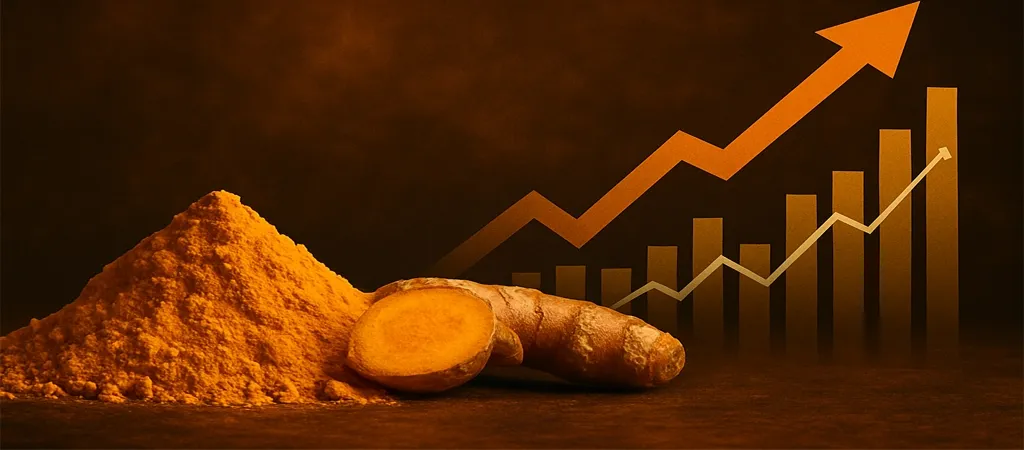A Short Supply Drives Prices to Several-Year Highs
The global turmeric markets are experiencing more pressure as supplies and harvests become smaller, while demand from local and export markets remains firm. In the last days, prices increased after a minimal fall: a fall of around USD 0.12 per kg was overturned as funds arrived, and spot prices increased by USD 0.05 to 0.06 per kg with respect to mandi rates.
Significant markets in India, such as Erode, Warangal, Nizamabad, Sangli, and Duggiral, experience issues with poor supply and quality, thus fewer products. For the upcoming season of 2024–2025, anticipated production stands around 6.2 million bags—significantly lower than the required 13 million to cover demand—so prices will increase and may hit a high of around USD 2.16/kg or beyond.

Detailed Global Price Summary
Turmeric rates globally are firm these days due to supply and demand issues. In growing countries like India, the spot rates are around USD 1.66–1.70 per kg. Rates remain firm as arrivals are lower, and processors, as well as export firms, are purchasing carefully.
The Indian export market for turmeric powder is well priced at a fair rate of around €3.50/kg (~USD 3.80). This indicates that it is of good quality and more sought after globally. Meanwhile, large buyers would like whole raw turmeric, and its price is around €2.70/kg (~USD 2.95).
Experts such as Ajay Kedia of Kedia Advisory believe prices will continue rising. He forecasted that because supplies in spot markets are limited and export demand is rising globally, turmeric prices will hit a record by 2025.
These prices remain stable because the Indian supply is limited. It is scarce because there are no build-ups and limited new crops. This makes export buyers active and prices stable.
Facts About Farming: More Land, Fewer Crops
Agarians in large farming states planted turmeric on roughly 10% additional land due to poor harvests from irregular rain, fungus issues, and lower root size. Though with additional land, abnormal weather, particularly in Nanded, decreased turmeric production per hectare by 10–15%, constraining supply.
Sowing higher doesn't imply a bigger harvest. In regions such as Sangli and Nizamabad, farmers are opting to sow crops that earn more money, such as corn or vegetables. This is reducing turmeric production further.
The spot markets demonstrate arrivals have been firm throughout the day--nearly 13,660 quintals against 11,940 during last season--but production quality is different.

Exporting And Competition With Foreign Nations
India produces 80% of everything in the world's turmeric and has sold 14,000 tonnes during November 2024, as compared to 8,600 tonnes during the previous year. Exporters realise more revenue through new high-grade crops.
Other nations such as Vietnam, Peru, Bangladesh, and Nigeria are getting increasingly competitive. Vietnam aims to export high-grade, organically produced crops to Western nations. Peru exported 20% more turmeric to Europe last 2024.
Good Value and Value: It's a Better Way
India aims to derive value from turmeric by producing curcumin powders and oleoresins. This will boost exports and prices. Export of oleoresin and curcumin, accounting for around 33,000 tonnes of raw turmeric annually, is itself rising.
Such regions as Kandhamal, Erode, Kaveripattinam, and Sangli are receiving Geographical Indication (GI) Tags, which enhances their perception in foreign nations.
The Indian producers are preparing for 2025. They have initiated a mission named “Making India the Global Hub for Turmeric.” This mission will concentrate on branding, using technology while farming, and quality enhancement.
Peering into Markets' Development Potential and Challenges
Global turmeric demand is strong, fueled by interest in its anti-inflammatory and antioxidant benefits. The sector is projected to grow from USD 4.4 billion in 2023 to USD 7.8 billion by 2033 (CAGR ~5.9%). Another outlook pegs the market near USD 4.7 billion by 2025, growing at around 13.5% annually.
Large markets such as Asia-Pacific (51–82% share), North America, and Europe are generating demand predominantly for food, cosmetics, healthy products, and clothing.
Though costs because of farming concerns, pest control measures, regulations, and supply lines remain large concerns. Purchasers face uncertain prices, thus forecasting expenses and making extended agreements is difficult.
Outlook: Involvement Plan for People
Apart from this, value can be achieved by processed products, branding of Geographical Indication products, and collaboration with European and American firms.
Buyers and importers would minimize risk by involving multiple sources—India, Vietnam, Peru—and entering into future contracts.
Policy and technology shifts (such as improved seed quality, better irrigation, and blockchain-based tracking) are crucial for robust supply systems.

The Ultimate Concept
The turmeric market is quite crucial these days, and supply is limited while demand is high globally. Various reports have indicated that residual inventory is minimal, sowing from previous crops is minimal, and major importing regions' demand is firm, hence prices remained stable until mid-2025. Still, a couple of new factors may decrease these prices shortly.
First, land that was planted for turmeric increased by roughly 10%, aiding in the limited supply. Although production per hectare decreased by roughly 10-15% due to poor weather and diseases among crops, producing on more land provides a positive prospect of increased production once later crops are reaped. Then, later in mid-2025, more products will become available on the market from the harvests.
This will reduce prices because farmers will also seek to benefit from good prices. Production from Nigeria, Peru, and Vietnam is increasing. These nations target powder markets and organic markets, and these influence other markets and prices globally. They will remain on average costlier later. But additional land available for sowing, almost ready crops, their harvest, and export orders can hold turmeric prices firm around mid-2025 and beyond.









